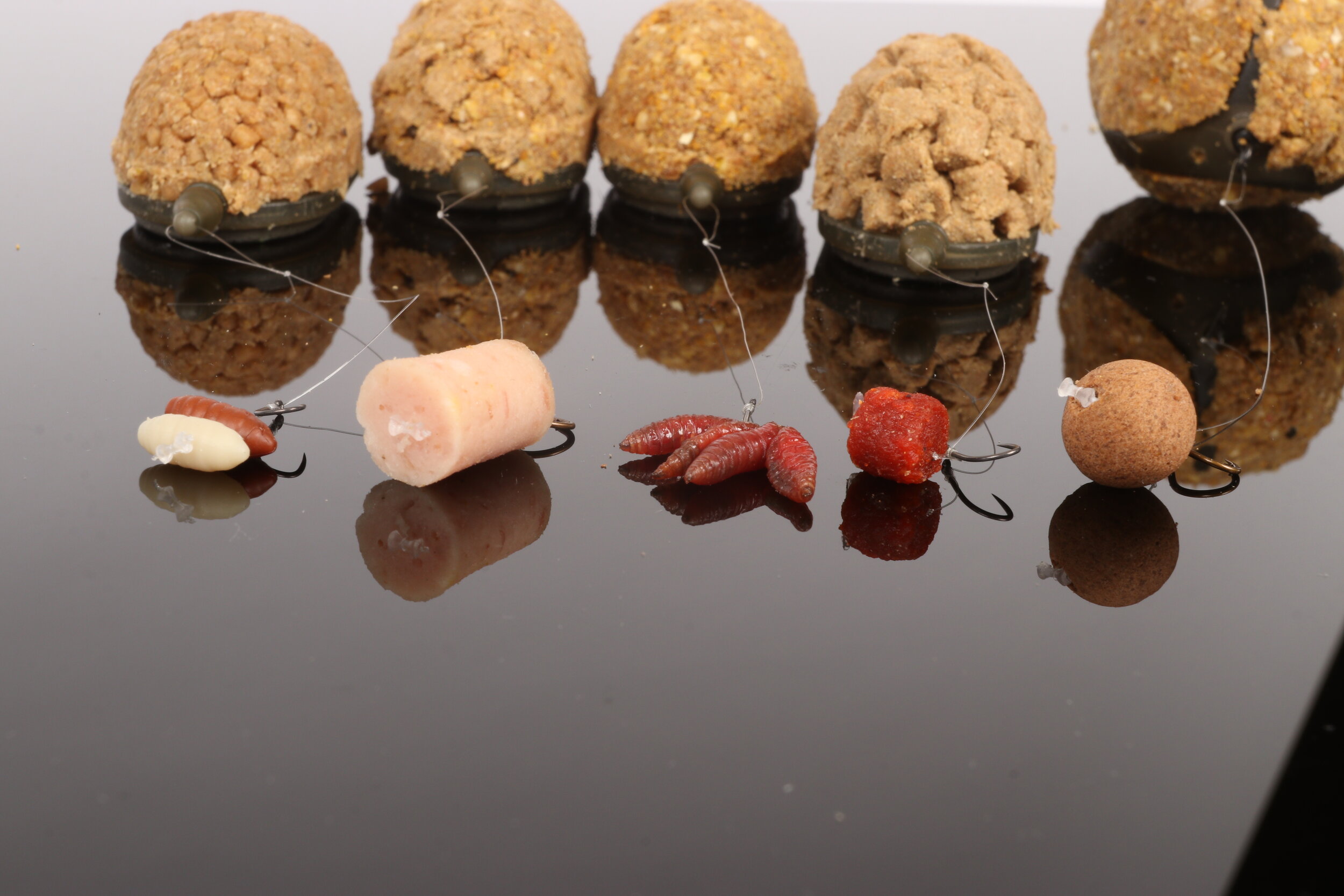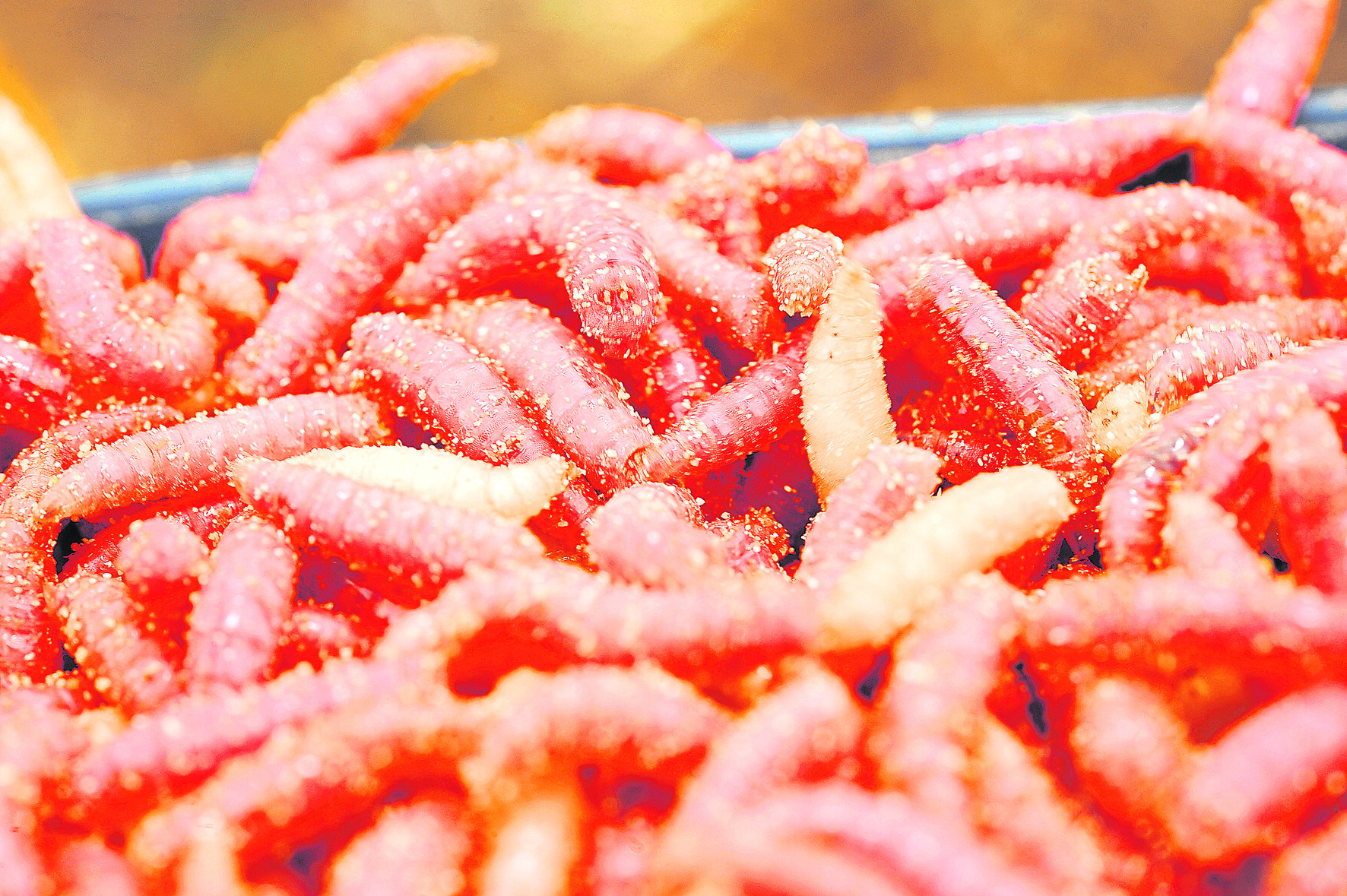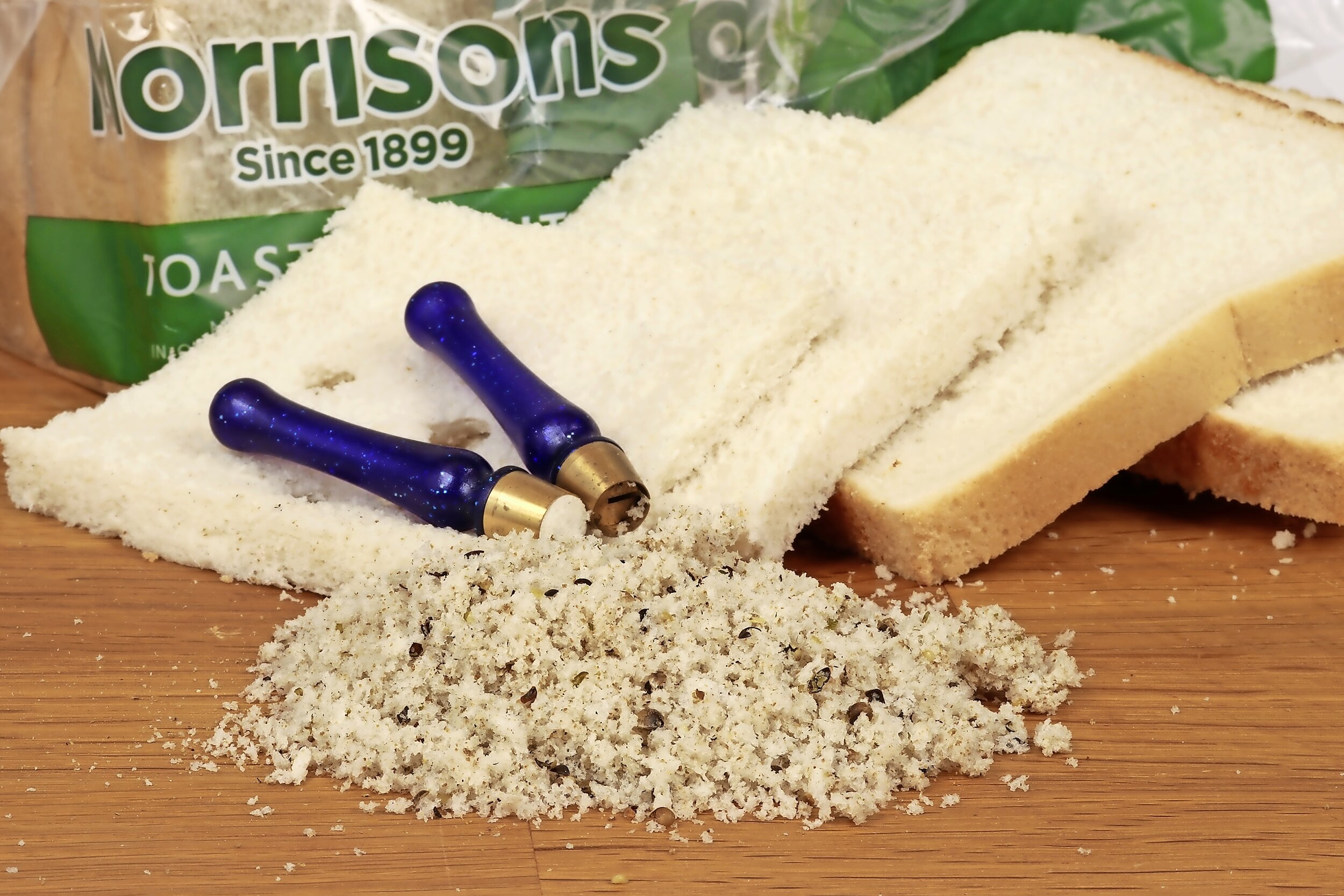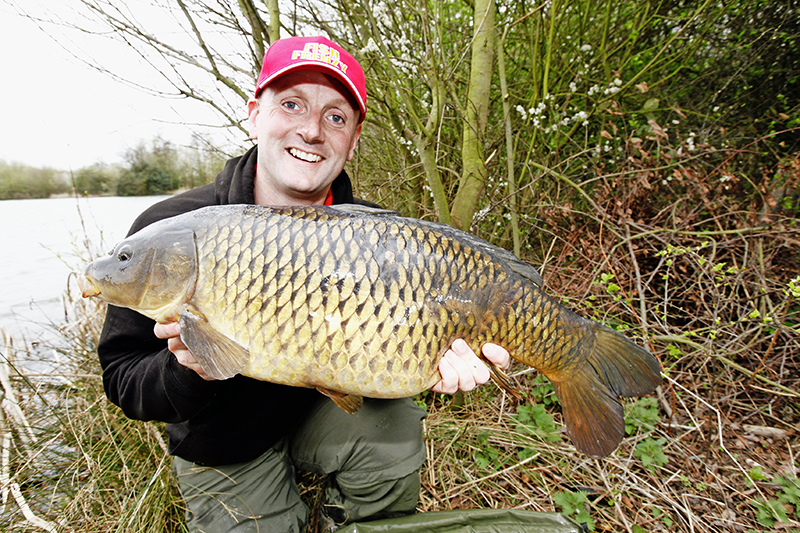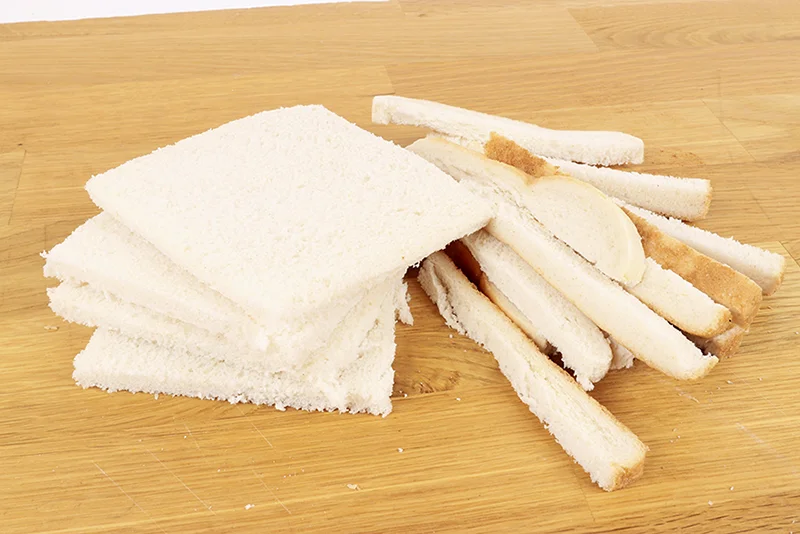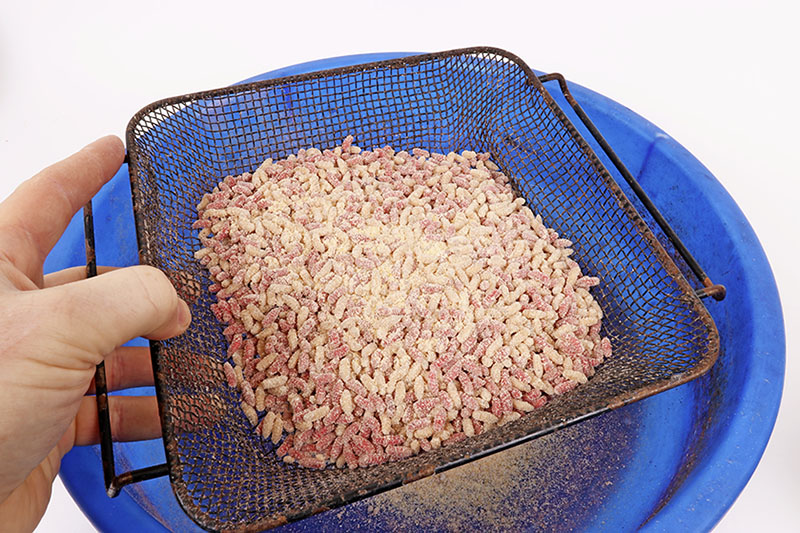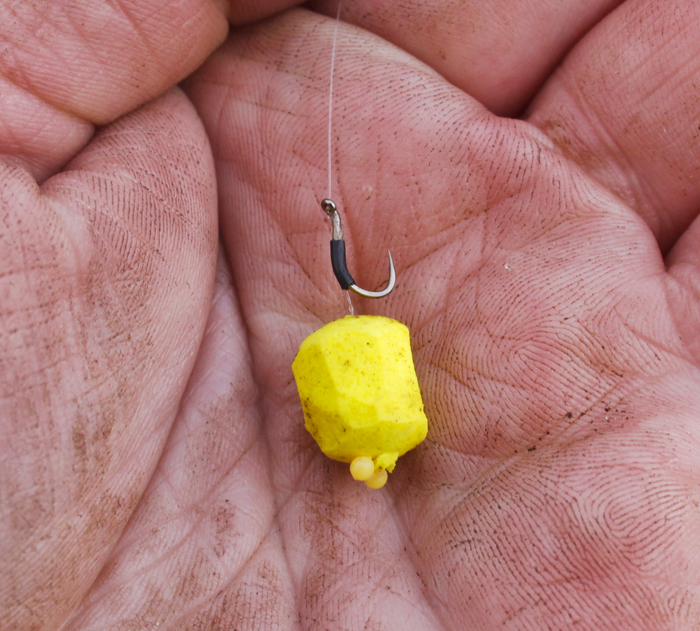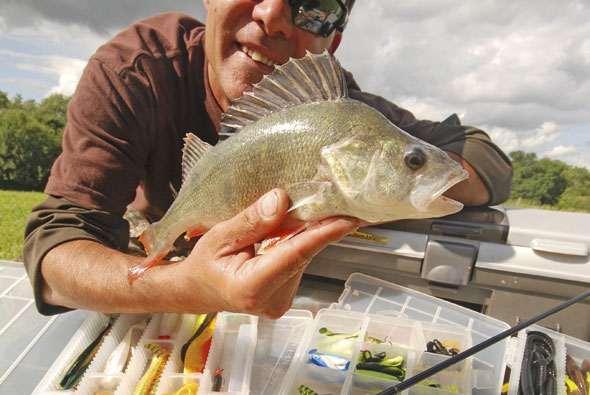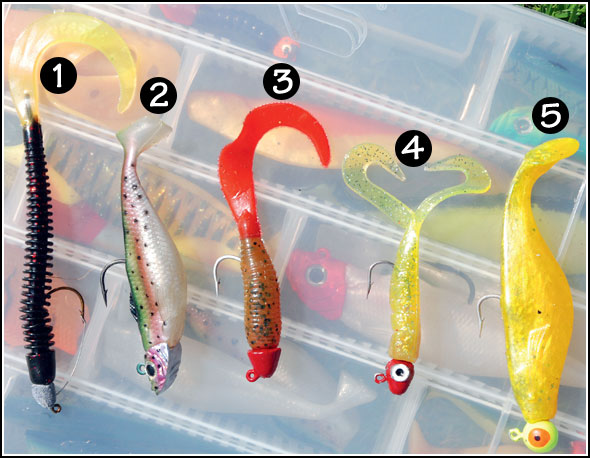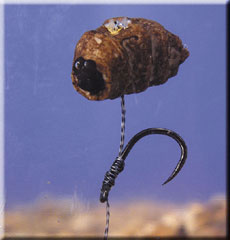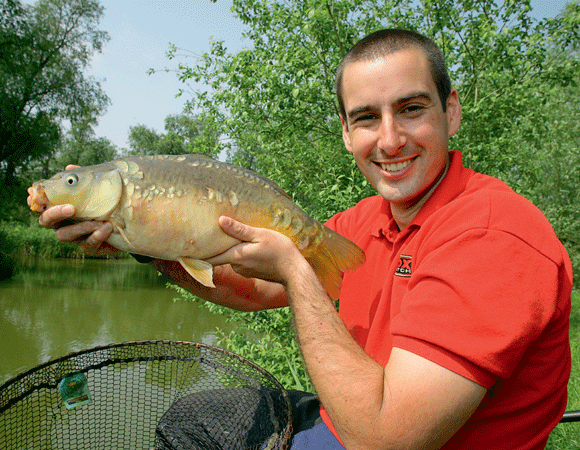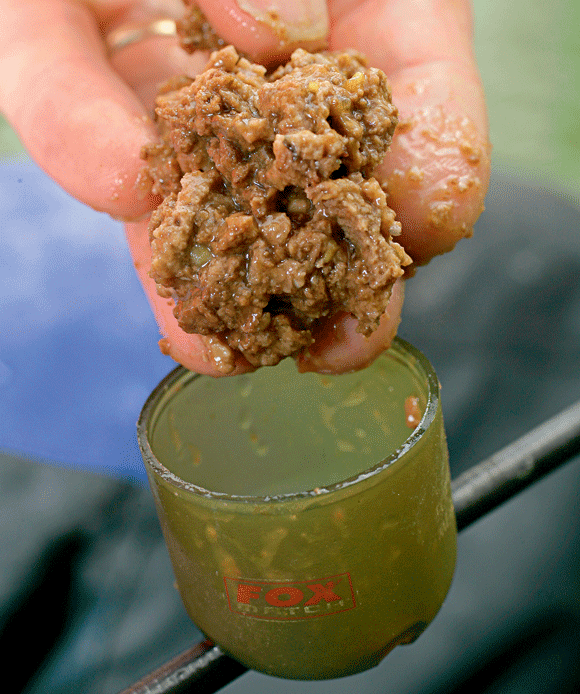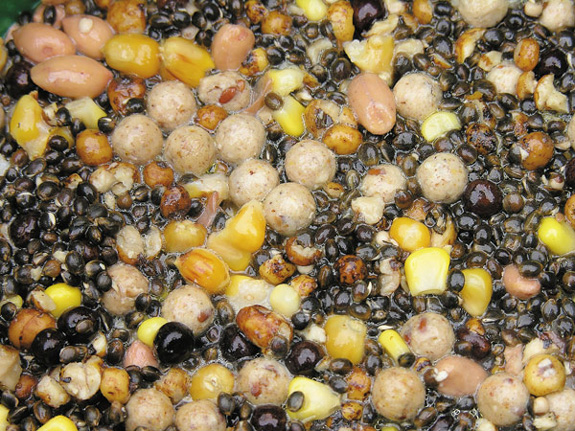Five baits that you must use when coarse fishing!
Check out bait expert Dr Paul Garner's best choices for bait this year...
Choosing just five baiting tactics that you must use for when you go fishing has been a surprisingly difficult task for me. It’s a case of being spoilt for choice – after all, there are just so many ways to catch fish and almost as many baits to use.
In the end my list came down to baits that will not only catch you more fish, but ones that will help you bag a new personal best and experience some high-adrenaline fishing. You’ll notice that soft plastic lures for perch fishing appear on the list – although these are artificial baits, they are fished very much like naturals, and are just as effective.
Here are my top five baits to use – you won’t be disappointed!
1) Catch carp on surface baits
There is no better way of catching carp than off the top, especially if you can get them feeding close in. That heart-in-mouth moment when a big pair of lips engulfs your hookbait and the line tightens is a million times more exciting than sitting behind a set of buzzers.
Yet still so few people have caught on to the adrenaline rush – in the main, I guess, because it can be a frustrating tactic as the carp refuse point-blank to eat your hookbait. Take my advice and find a well-stocked venue to begin your surface fishing quest. Take some 11mm floating pellets and catapult these upwind of any carp you spot sunning themselves on the surface. Now wait.
Don’t even think about making that first cast until the carp are charging from one bait to the next in a race to beat their shoal-mates to the free grub. Only then is it time to flick a freelined pellet or marshmallow out – and success will be virtually guaranteed.
2) Target perch on lures
Numbers of big perch are booming at the moment, although history tells us that this won’t necessarily always be the case – back in the 1960s our stocks were almost wiped out my a mystery disease, and that could happen again without warning.
All the more reason, then, to make sure you bag yourself a specimen stripey this year. While the humble lobworm or a small livebait will account for a lot of chunky perch, soft plastic lures take some beating if you want to net a real biggie.
Drop shotting is the method of the moment – but it is not the only lure fishing technique to use. With the weight anchoring the small soft plastic grub tight to the bottom, drop shotting is great on days when the perch are close to the bottom. This is especially the case during cold weather.
Much of the time, though, perch can be found in midwater and a drop shot is likely to present a lure too deep. Switching to a bright green 2ins-3ins long paddle tail lure on a tiny 1/4oz jig head is then much more effective, as it can be retrieved at any depth. Simply count the lure down as it sinks, start close to the bottom and then with each cast reduce the time before you start the retrieve to fish at different depths.
3) Make your own gel hookbaits
With a plethora of brilliant baits available straight from your local tackle shop, you may wonder why I still insist on making many of my own baits. It has to be said that I enjoy ‘messing about with bait’, but I genuinely believe that making your own gives you the freedom to come up with something a bit different from the norm.
I think my home-made gel baits definitely give me an edge. I often use them with the Method feeder, but they are just as useful for other tactics. Using gelatine or Veg-e-gel powder, available from the cooking section of supermarkets, I can set any liquid or powdered additives into a firm bait that literally melts slowly in water. Best of all, I can make a batch of bait in just five minutes. This is very different to other Method hookbaits, and has caught me fish on days when other baits have failed to work and gives me total control of the bait I use.
4) Spray pellets for chub
On my West Midlands rivers chub numbers are booming, with shoals of hungry two to five-pounders providing fantastic sport on float and feeder. These fish have grown up seeing pellets nine months of the year, thanks to barbel anglers. So pellets are obvious baits to target these chunky chevins.
A small Kamasan Blackcap feeder loaded with 3mm pellets works well, but not only more effective, but much more fun is to fish a pellet waggler tight against far-bank overhangs and spray 6mm pellets.
Expect bold bites as the chub compete for the free food. For best results keep a constant flow of pellets going in – the longer you feed, the more the chub will lose their natural wariness and the more fish you will put in the net.
5) Use boilies for specimen barbel
If a big barbel is at the top of your bucket-list for 2017, take my advice and use boilies. You may not catch as many, but my trials have revealed a massive increase in the average size of the fish I have caught on big baits.
Don’t be afraid to go-large either – 18mm or 20mm baits, fished either singly or doubled-up, make a decent mouthful for a double-figure barbel. Expect to catch few male fish under 7lb, but the large females will be suckers for a decent meal.
Most barbel tend to be caught on savoury-flavoured boilies, simply because that is what most people use, but dare to be different. Sure, you will catch on meat or fish-flavoured baits, but curry spices work great, especially in colder conditions, and I have found sweet flavours to be equally effective. Chances are no one else will be using them.
There is no point in feeding hemp or pellets if you are fishing with large boilies. Stick to just large baits, introducing a handful of bait on a PVA stringer and catapulting the odd boilie upstream to top-up the swim.
Paul Garner's top tips for colouring your bait!
One of the easiest changes you can make to many baits is to alter the colour, but does this really make any difference to catches? I don’t think that fish are attracted to any one colour, but some are definitely more visible than others in different venues, and this can influence our results.
On heavily pressured venues, using a colour that is different from the norm can also catch you more fish, especially if you use some of the more obscure hues.
What can coarse fish see?
Coarse fish have eyes that are not much different from ours. However, they can see some ultraviolet light beyond the blue end of the spectrum that we can see, useful in deep water where most light is at this end of the spectrum. Rather than what colours fish can see, we would be better asking what colours are visible in the murky depths of a river, or the clear water of a lake? Light at the red end of the spectrum is actually absorbed quite quickly. If you go down to 30 feet then even in a gin-clear lake, reds will appear as shades of grey.
Most of the time, though, we aren’t fishing in water anything like this deep, so the colours we see are not that different to what the fish will be seeing too. At night colour becomes less important. Even though fish can see quite clearly on even a moonless night, they will see in black and white, with bright colours appearing as lighter shades of grey and dark colours like red appearing almost black.
Paul's top tips for dyeing your baits
Many baits will take colours easily, and some anglers who have experimented with unusual combinations have enjoyed surprising success until the fish become ‘wised up’ to them.
Why not experiment yourself, with simple food colourings? The sky’s the limit!
1)
As a general rule, you can make light-coloured baits darker, but you can’t make dark baits lighter. So remember this when colouring your baits. chickpeas, for example, will take red dye easily.
2)
Baits that are naturally moist, such as sweetcorn and chickpeas, can be easily coloured using powdered dyes.
3)
Chop meat into chunks or cubes and then lightly spray on some liquid dye. After a few hours the meat will absorb it.
4)
Groundbaits can be dyed using powdered colours added to the dry ingredients before mixing. Use dark in clear water.
5)
Maggots are very difficult to colour at home, so it is best to leave it up to the experts and buy them ready-dyed.
Paul Garners easy 10 minute rolled bread carp hookbait!
Bread is one of the best winter baits for carp. Its complex structure of means that it is light in water, making it easy for carp to pick up, and big baits can be used as it has very little substance. Bread lends itself to a whole host of tactics, so why not give it a go?
Follow these six simple and easy steps to be able to create the perfect rolled bread hookbait.
Step 1
Cut the crusts off several slices of white bread. It’s worth buying a good quality loaf for hookbaits.
Step 2
Sprinkle a pinch of krill powder or similar powdered additive on to the bread slices.
Step 3
Gently roll the slices of bread with a rolling pin or bottle. The aim is to reduce the thickness by half.
Step 4
Try rolling two or three slices together as an alternative to a single slice.
Step 5
Punch out the hookbaits. It is worth experimenting with different sizes of punch.
Step 6
Hair-rig the punched bread. A Quick Stop is the easiest, most secure way to keep it in place.
Quick tip
If the bites dry up on bread, try adding a couple of maggots to the hook. ‘Bread with legs’ is a classic cocktail bait at any time of the year, and one that can see you catching a wider range of species than bread alone.
Steve Ringer's favourite corn hookbaits for carp!
I use both corn and wafters for hookbaits, and will change my hook based upon which bait I’m using. When fishing corn on the hair I’ll use a size 18 Super MWG.
If I change hookbaits from corn to a yellow wafter I will switch to a size 14 QM1 hook and a 0.17mm hooklength – still 75cm long, of course.
In terms of hookbait choice, contrary to popular belief corn gives you quite a few! To simplify things, though, there are three I like to concentrate on...
1) Corn stack
This involves hair-rigging multiple grains through the narrowest part. The advantage of fishing a stack is that you are creating a big, stand-out bait and offering the carp something a little different to what they are used to.
2) Dumbell wafter
A 10mm yellow dumbell wafter resembles a grain of corn and blends in well with the loose offerings. It has two key benefits over the corn – being so light it sinks very slowly through the water, increasing the chances of a carp seeing it and following it down. Then, once on the bottom, it becomes a very light hookbait that is easily sucked up by a feeding fish.
3) Corn string
This is a real favourite of mine. The ‘string’ is a number of grains hair-rigged through the long part of the grain, and gives the fish an easy bait to spot. It gives the appearance of multiple grains lying next to each other on the bottom, and fish can pick up a lot of feed in one easy go.
Paul Garner's 10 minute big carp grub mix!
You can use maggots on their own, but on well-stocked lakes where the carp are used to finding plenty of bait I will bulk out my feed a little.
The idea is to get the carp grubbing around and homing in on the maggot hookbait. This mix is ideal for use in PVA bags and for spodding out.
Follow these easy steps below to have your big carp mix ready in minutes.
Pop-up baits vs. Bottom baits
Fishing is all about the choices you make. There are many variables, but in carping one of the key decisions is whether to present your hookbait on the bottom or just above it.
Pop-up baits
Bottom baits
POP-UP BAITS
PRESENTATION
All rigs can tangle or get caught on detritus as the lead plummets through the water, but the buoyancy of a pop-up bait is much more likely to suspend your hook away from such problems. The distance between the lakebed and the bait can be infinitely tweaked, but do wise carp find a ‘hovering boilie’ suspicous?
TO BLEND IN OR STAND OUT?
The problem with pop-ups is that every single one of them is attached to a hook. Your free offerings cannot be suspended off the bottom like the hookbait and some anglers believe this means they stand out like a sore thumb. Conversely, standing out like this can be an advantage as carp home in on an eye-catching offering.
EASE OF USE
The rigs used to present baits off the lakebed needn’t be dauntingly complicated, but they do require a bit of thought. The weight needed to anchor the bait (either with putty, a split shot or sinker) is a consideration, and popular rigs like the chod and hinged stiff rig require concentration and practice to make perfect.
OTHER CONSIDERATIONS
A tub of pop-ups isn’t cheap, but who said all suspended rigs need to be made with boilies? Plastic baits like imitation corn are wonderful carp catchers and will last for session after session, fish after fish. Pop-up boilies are also generally much more durable than feed baits, meaning they can live in your rucksack for years.
BOTTOM BAITS
PRESENTATION
The vast majority of loosefeed you introduce into the water will collect on the bottom, and with their tough lips and underslung mouths, carp are also used to foraging for natural grub down here. But rig-obstructing debris also gathers on the lakebed, so bottom baits are best suited to clear areas where you know nothing will foul your hook.
TO BLEND IN OR STAND OUT?
It’s far harder for a carp to differentiate between a free meal and a boilie attached to a rig if both baits look and act the same. Shop-bought pop-ups cannot, and often do not, attempt to match the sinking boilies you pluck from a bag. With a bottom bait, this potential problem is eliminated and the carp has a far harder choice to make.
EASE OF USE
Bottom-bait rigs are generally simple. We’re lucky to sit here in 2014 with access to the knowledge gained by the pioneering anglers of years gone by. We know that anything mounted on a hair rig is very capable of catching fish. Bottom-bait rigs can be tied in seconds with supple or stiff materials, but they all work.
OTHER CONSIDERATIONS
It might be tempting to think popped-up baits are simple, and buoyant shop-bought boilies certainly are, but carp fishing isn’t all about these hardened spheres. If you want to fish tiger nuts, sweetcorn or pellets then presenting them on the bottom is by far and away the easiest way to do so quickly and effectively.
THE NEXT LEVEL: WAFTERS AND CRITICALLY BALANCED BAITS
What do you get if you cross a sinking bait with a buoyant one? A snowman.
No, we haven’t muddled up our Christmas-cracker jokes – one of the compromises between pop-ups and bottom baits is the snowman rig.
So called because, well, it looks like one, the snowman features a smaller pop-up mounted on top of a larger bottom bait. The result is a two-bait presentation that sits ‘upright’ on the lakebed, giving fish more chance to see it.
The buoyancy also counteracts the weight of the hook, theoretically fooling the fish into thinking the mouthful it has just picked up is not attached to anything. With a bit of tinkering, the two baits can be matched so that they fall gently through the water to rest on any bottom debris.
How to use popped-up baits
Times change, even for a five-times World Champion. New methods and baits need to be mastered to keep pace with the modern match scene, and that’s exactly the situation I found myself in this winter when fishing the Hayfield Lakes Pairs Series.
I’d thought that bloodworm for roach and skimmers would play a big part, but after the opening round, when carp fed all around the lakes and relegated my 15lb of silverfish to nowhere in the section, a radical rethink was needed – I’d have to catch some carp!
At Hayfield the fish run big and show a liking for swimming around a few feet off the bottom, so baits fished on the deck are often left untouched. Popped-up baits rule, but I’d hardly ever used them before.
However, on the winter commercial fishery match scene they’ve become more and more popular and productive, so I had to bite the bullet, trawl the carp section of the tackle shop for baits and dips and get experimenting.
I also tapped up anglers like Steve Ringer, who know a bit about pop-ups and carp. Armed with his advice and a bagful of weird and wonderful hookbaits, I was ready to do battle on the Island Lake at the Doncaster water.
KEEP ON CASTING
Luridly-coloured boilies and pellets or white discs of bread are unmissable in clear water, which is why pop-ups work.
You rarely feed anything when fishing these, and it isn’t a tactic where you cast to the same spot time and time again.
Each cast should go to a different part of the swim. In cold water fish are unwilling to move any distance to pick off a bait, but not unwilling to feed. That means a bait could well sit a foot away from a fish but never be taken. Land it on its nose, though, and a take should be pretty quick in coming.
If you see a carp top, reel in and cast to it immediately as this will be a feeding fish.
HOW FAR?
In 10ft of water the fish could be anywhere, and that means a lot of playing about with the way you pop up the bait. However, I’ll also use my quivertip to ‘read’ where the fish are in the water column. A knock on the tip but no take tells me that the fish are perhaps under the bait, hitting the line, so a shortened hooklength is the first port of call. No bites but fish moving tell me to lengthen the tail and fish a bait higher in the water.
Tosave time I carry dozensof ready-tied hooklengths from 1ft to 6ft long in a carper’s rig bin. These can be changed in seconds by using a snap link and hooking the loop of the hooklength on to it. These aremade from 4lb-5lb Drennan Supplex to a super-sharp size 12 or 14 Drennan Power Hair Rigger hook.
I’ll start at a foot off bottom and give each cast around 20 minutes before winding in and recasting. Often the first cast of the day is the most important as it will land somewhere near a fish and find it at its most willing to feed, so be fully prepared early doors.
Just like when fishing on the deck, you’ll typically get a nudge on the tip before it pulls around or drops back. Slow line bites that gradually pull the tip around should be ignored.
HOOKBAITS
This is where it starts getting complicated and it can all be too much to take in, given the sheer variety of size, shape and colour of baits. As ever, keeping it simple is best and I’d limit myself to bread, boilies and pellets for popping-up, always starting on three 10mm discs of bread punched out and allowed to swell up in the water into a hi-viz mouthful for the carp.
Large floating expander pellets of around 12mm-14mm diameter are also a good bait, especially on waters that see a lot of pellets piled in. These are fished as singles, drilled out and mounted on the hair.
That leaves boilies to cover, and while I’m unsure that carp can sense flavours quickly, they can certainly pick out colours. I’ll carry yellow, white and red mini boilies and dumbels in 8mm-12mm sizes and try them all as singles throughout the day.
ALTER THE SHAPE
Rather than chucking out a normal round boilie I’ll alter the shape of it using a craft knife on the bank, carving it into a square shape to try and mimic a pellet.
This is a trick a lot of top carp anglers do, and if it’s good enough for them it’s good enough for me. You can do the same with pellets, while the flattened elongated dumbell boilies offer the fish something different too, and are well worth a cast or three.
ALAN'S FEEDING
Does feeding work? My answer to this would be ‘no’ on the whole because you’re relying on the attraction of the pop-up to catch.
However, if there’s nothing to lose then a few 8mm hard pellets pinged in every 10 minutes can draw a few fish in, especially on balmy winter days when the carp might be hungry and starting to think about going after some food.
While it remains cold though, leave the catapult in the bag.
BACK-UP TACTIC
Be prepared to accept that pop-ups aren’t the be-all and end-all. There will be days when they don’t work and the carp will be feeding on the bottom, but working this out is easy –
the tip won’t move and you’ll start worrying!
The remedy is simple, though – a change of bait to traditional pellet, meat and corn fished on the deck.
An 8mm or 10mm punch of meat, two grains of corn stacked back-to-back and single or double 6mm drilled hard pellets are all good fish-catchers, used on a short 12ins hooklength, and when you change to fishing on the bottom you can also feed a little more, ideally with a tiny PVA bag of pellets to encourage the fish to get their heads down.
POP-UP BAITS
Spicy meat-flavoured dumbbell, pineapple pop-up, oily floating pellet, white chocolate dumbbell, toffee/chocolate flavoured pop-up, mini fishmeal pop-up, three 10mm bread discs make a good change bait from boilies and pellets
How to present buoyant artificial baits pop-up style
Most artificial rubber or plastic sweetcorn grains, maggots, casters, pellets and the like float and that gives anglers a challenge when it comes to presenting them correctly.
Such artificial baits like bread and dog biscuits don’t pose so much of a problem as they are designed to be fished on the surface anyway, so you don’t have to make great alterations to your rig – you can simply fish these baits as you would fish real bread or dog biscuits.
Most other artificial baits need treating differently though, to ensure that you present them as close as possible to how the natural baits look when they come to rest on the bottom.
HOW TO DO IT
Let’s take a grain or two of artificial sweetcorn as an example. First of all you are going to have to fish the rubber or plastic corn kernel upon a hair rig because there’s no way that your hook will ever pull out of the bait if it were side hooked - you’d lose every fish that you hook.
Now, once the bait is on the hair rig it will float unless you alter your rig slightly so that the bait is pulled down to the bottom.
To do this you need to create an anchor for the bait and two of the best forms of anchor are either split shot or tungsten putty. Kryston make arguably the best and it’s called Heavy Metal. This malleable tungsten putty can be rolled between your fingertips to warm it up slightly, then it can be rolled onto the hooklength to create a streamlined weight.
WHERE TO ANCHOR YOUR BAIT
This is quite critical as the position you place your anchor will determine how far the bait sits off the bottom. And then you will have to take into account the make-up of the venue’s bottom. Is it free from weed? Is it silty? Does it have an abundance of Canadian pondweed on the bottom? All these things will make a difference to where you position the anchor for your bait.
On clean and clear bottoms placing your split shot or tungsten putty anchor around 2in away from the hook works well. This will make the bait sit off the bottom by 2in, obviously!
A 2in lift off the bottom isn’t going to look too unnatural, and believe us you’ll get plenty of runs with a bait presented that far off the bottom.
If the venue is silty we would recommend having a 4in to 6in gap between the hook and the anchor weight/s as the weight may sink into the silt but the distance between the weight and the hook will ensure that the bait sits proud of the silt where the fish will be able to find it.
If the venue is very weedy try using a gap of 12in between the hook and your anchor weight so that the imitation bait rises up through the weed and doesn’t become entangled within it.
HOW MUCH WEIGHT TO USE
The amount of split shot or tungsten putty you will need to use down the line will depend upon the buoyancy and size and number of fake baits that you intend to use. As they all vary slightly in buoyancy the only way to find out is to bait your hair rig with whatever fake bait you’re using, add a little weight onto the hooklength and lower the hooklength into the margins to see how the bait performs under the weight of the shot or putty that you’ve used.
The rule of thumb here is to use just enough to pull the bait down – don’t use excessive amounts of shot or a big lump of putty as it’s not necessary. In most situations a BB shot will be enough, or a chunk of putty the size of a 1p.
THE RIGHT HOOKLENGTH
The key to success here is to use a flexible hooklength, so that rules out thick fluorocarbon as that stuff just refuses to bend!
The best hooklength to use is braid as it is soft, supple and will bend really easily at the shot/weight to create a hinge up towards the popped-up bait.
Monofilament is second best as it prefers to lay straight and won’t produce a perfect L-shape at the point where the weight is placed.
As regards the length of the hook link material, that’s up to you. Generally speaking a Method hooklength will be anywhere between 3in and 12in, a specialist semi-fixed bolt rig hooklength will be around 4in to 8in, while a general purpose feeder/leger hooklength will be anywhere between 12in and 3ft. The choice is yours.
POPPING UP OFF THE LEAD
This is a technique that many anglers use when fishing the Method. The buoyant fake bait is fished upon a short hooklength of between 2in and 6in that is tied directly to the bottom swivel of an in-line Method feeder and no weight is used to anchor the bait to the lake bed. Once the rig is cast out the groundbait around the frame feeder breaks down and the fake bait rises upwards to sit between 2in and 6in above it.
Why do fake plastic baits still catch fish?
It seems baffling that any fish in its right mind would ever be caught on a fake plastic bait, but the fact of the matter is they do, and many thousands of huge fish are caught each year on artificial fishing baits.
For hundreds of years pike anglers have been catching their quarry using fake baits, either spinners, spoons or lures, with fantastic results. So why shouldn’t other non-predatory coarse fish suck up a fake bait?
It stands to reason that they should, after all a fish is a fish regardless of its species and where it lives.
The only reason that pike anglers catch fish using artificial baits is because they cast out their baits to the right place at the right time. Some say they catch the pike because they have made the pike angry, but that’s incidental – the bait still has to be in the right place at the right time.
And that’s all there is to catching coarse fish using plastic baits – they have to be cast and presented correctly in the right place at the right time – just like any other bait.
ADVANTAGES OF USING FAKE BAITS
The number one reason why anglers use imitation fishing baits is because they are trying to target specific species such as carp, bream, tench or barbel and they do not want there bait to be chewed and ruined by smaller fish such as rudd, roach, gudgeon or skimmer bream. And one way to prevent that happening is to use a tough, fake bait that cannot be chewed and destroyed.
Other reasons include the ability to easily present a popped-up bait off the bottom where the fish can easily see it, and there’s also the advantage that imitation baits can’t be knocked off the hook or break down like bread, dog biscuits or pellets do.
Finally, you try casting a piece of side-hooked bread crust 50 yards to surface feeding carp. It’s impossible – but not when you use fake bread.
WHY TO FISH TAKE THEM?
There’s no scientific reason why fish take fake baits – the answer is quite simple and not mysterious in any way. They simply fool the fish into thinking that the bait is just the same as natural baits like corn or man-made baits such as pellets.
So long as you are fishing in the right place at the right time and your bait looks natural in the water a fish will come along and take it.
ADDING SCENT TO FAKE BAITS
Most fake baits are simply look-alikes. They don’t smell like the real thing. So in order to attract the fish into your swim out of visual range you’ll have to introduce some scent or face waiting a while for a fish to pass and spot the bait.
This can be done to two ways: you can either flavour the fake bait or you can introduce real items of scented attractants or feed baits.
Flavouring your fake bait isn’t the best option as sooner or later the smell will have fully dispersed. To flavour the baits simply store them in a small canister (a camera film pot is ideal) floating in a liquid additive that suits the bait.
The second method is the most successful though where you feed the real thing around your fake bait – like real grains of corn over the top of your fake corn bait. Or try using a groundbait, a bed or hemp, a bed of pellets or a PVA bag filled with good attractors known to tempt the fish you are targeting.
10 WAY TO USE FAKE BAITS
1) Tip pellets and boilies with fake corn
Tipping bottom baits like boilies and pellets with a piece of buoyant fake corn has several benefits.
First, the brightly-coloured corn helps the hookbait stand out from the crowd, meaning that you get bites faster as the fish home in on the hookbait. Equally importantly, using buoyant corn will counterbalance the weight of the hook and bait, so when a fish sucks up the hookbait it will travel further back in the mouth, securing a better hookhold.
2) Create a tench T-rig
Developed by ingenious tench anglers, the T-rig is a great way of presenting a stack of fake maggots that doesn’t look like a stack! With the baits threaded on to the hair in a T-shape the fake baits stand proud and are more noticeable.
The unusual shape also makes it harder for rig-shy tench to eject the hookbait. Try this presentation over a bed of dead red maggots.
3) Fish a balanced corn stack
Combining floating and sinking fake baits allows you to adjust their buoyancy and make a wafter-style hookbait that is very easy for the fish to pick up. The stack of corn sits upright off the bottom with the hook beneath – very visible but with the metal hidden. Using micro corn at the top gives a more streamlined presentation.
4) Pop-up fake bread
Whether targeting carp or chub, popped-up bread can be very effective, but it takes confidence to cast out such a fragile bait.
Why not replace the real thing with a chunk of fake bread? Use a short hair rig and also hook the bread on, so that it sits really tight to the hook. This way you will definitely hit more chub bites on the river.
5) Hair-rig a fake maggot on the Method feeder
Most of the record-rocking crucians caught over the last few seasons have fallen to fake baits, normally maggots or casters, fished with a small Method feeder loaded with either micro pellets or groundbait. For best results use a size 14 or 16 hook and trim the maggot down so that the hook only just sinks.
6) Make a surface-sighter
Spotting your mixer in a flotilla of other floating baits can be a nightmare, and many’s the time I have struck when the wrong bait has been taken, ruining my chances of catching a big carp!
Now, I always use a ‘sighter’ – a small piece of coloured foam or a pop-up boilie above the mixer – so that I can identify the hookbait amid the feed. A small piece of fake bread is the ideal sighter, proving to be very visible as well as adding to the buoyancy of the hookbait.
7) Tie a medusa rig
This conspicuous real maggot and fake corn combo has taken many big carp, bream and tench. Use it with a PVA bag of maggots attached via a maggot clip below the inline lead and a short braided hooklength. A size 14 hook is tied to the hair and a piece of fake buoyant corn is threaded on and the small hook pulled into it. A size 10 hook is then tied on to leave a small gap between hook and corn. Three maggots complete the rig.
8) Beat small fish with fake maggots
Barbel love maggots, but small chub and dace can make using them on the hook a nightmare, especially at this time of the year on the river. My solution is to replace the real thing with fake maggots on the hair. While small fish will leave the hookbait alone, the barbel are unable to distinguish them from the real thing and will hoover the whole lot up in one go. Fill a large oval blockend feeder with red maggots, and remember to keep recasting regularly to get that trail of maggots going downstream.
9) Dob bread on the surface
Carp are suckers for surface baits at this time of year, but birdlife can make feeding floating baits a real pain in the backside. Instead, I will often rely on the pulling power of a boosted hookbait to attract the carp’s attention. The spongy nature of fake bread is ideal for dipping in liquid additives, and it can then be sprinkled with powdered attractors that will stick to the outside, giving off even more attraction. Dunk the hookbait close to a carp and watch it search out the source of the smell.
10) Make a mag-aligner
This clever rig was originally developed for winter carp fishing, when maggots are the number one bait on many venues.
Since then it has proved super-effective for chub and barbel in the cold and tench in the summer too. With a sewing needle, carefully thread a sinking bronze maggot on to a soft braided hooklength. Now tie on a size 10 hook and pull the fake maggot on to the shank. The fake bait helps to disguise the hook and also acts as a line-aligner, helping the hook to turn in the mouth and prick the fish. With a couple of real maggots on the hook the rig is all set.
Fishing with liquidised sweetcorn
If you are looking for an edge when fishing a commercial carp water during spring, summer, autumn or winter, you will do well by fishing a grain of corn directly over the top of a cloud of liquidised sweetcorn.
Mushed up grains of sweetcorn are absolutely deadly on some commercial waters due to two reasons. Firstly the crushed up kernels produce a yellow, milk-like cloud in the water that disperses flavour throughout the depths pulling fish in from all angles.
Secondly this technique provides masses of attractants but very little food - the only food that the carp will find are small taorn kernels of corn so your whole corn hookbait will stand out like a sore thumb, providing an ideal target for the fish to home in on.
During the winter, when the water temperature is at its lowest, the water is also at its densest. This increase in density means that the cloud spreading out from liquidised corn will linger in the water for longer, attracting fish from far and wide.
Once the fish are attracted to the area, there is little for them to eat except the hookbait. This will mean you get more bites.
Here’s how you make and use it:
1. Tip the tin of corn, juices and all, into a food processor or blender...
2. Do not obliterate the kernels when preparing liquidised corn - give the tinful of corn a five to 10 second blitz then check it and repeat if needed.
3. The finished corn mush should retain a few bits of kernel for the fish to pick over. This helps to hold the fish in the area once the sweet cloud of feed has attracted them.
4. To feed the liquidised corn you must use a pole cup. Dribble a pinch of corn mush into the cup, carefully ship out to the exact spot you’re fishing and drop it into the water. Look at the cloud that spreads out.
TOP TIP
When liquidising sweetcorn, it is possible to add flavours or colours to the mixture to give it a different signature if you wish.
Try fishing with plastic baits to catch big perch
Matt Hayes shows how simple and cheap lure fishing bags specimen perch at this time of year
Bold, aggressive and built to kill, perch are the secret assassins of modern stillwaters.
While most anglers would instantly respond with the word ‘pike’ when asked to name a freshwater predator, the perch has now become top dog in the food chain on many venues.
With many managed waters now devoid of pike, the perch has become the number one predator and in venues boasting a large stock of prolific breeders – typically carp, roach and bream – the source of prey food has risen to banquet levels.
There’s never been a better time to be a perch as the record number of specimens in our lakes testifies.
What’s more, autumn is prime time for perch fishing. Cooler temperatures, less intense sunlight and shorter days means perch can exploit their predatory advantages to the maximum.
As the clarity of water improves and the perch reach a fever pitch of aggressive hunting behaviour, a golden opportunity is created for outstanding lure sport.
Lure fishing – the use of an artificial bait to mimic a fish – is best when predatory fish are active and the clarity of the water is good.
Every autumn I spend a few days fishing for specimen stillwater perch and I often rely on a family of lures known as soft plastics.
These fish-shaped rubbery lures come in thousands of designs, sizes and colours but each is supposed to trick a perch into thinking the target is a small prey fish.
So, as we enter ‘perch time’, I’m going to detail tackle and tactics needed to catch stripies on soft plastics.
The advice I’m giving you will be a good guide to fishing over the next month or two and then again in late March and April when spring feeding conditions mimic those you find now…
Get the right kit
Working a soft plastic lure on an old float or feeder rod really isn’t good enough and if you’re going to lure fish properly you need a few bits of kit that will do a specific job.
Here’s a list of tackle you need, but the good news is you won’t need to remortgage the house. Lure fishing only requires you to buy a few pieces of relatively cheap tackle:
1 - Light lure rod
You need a short, lightweight rod which is comfortable to hold all day, one which is responsive to the lure as it’s worked through the water.
A 6ft-7ft carbon lure rod, with a casting weight rating of 5-15 grams is ideal. I’ve got a couple of old Shimano rods that are no longer available but I suggest you look at the Fox Elite Jig lightweight (£85-ish), the 7ft Berkley Series One Spin (approx £70), the Abu Sapphire Crest Spin rod at about £45 or the Daiwa Regal (£30) and Super Shinobi rods (£70).
2 - Reel and braid
Of all the kit you need a braided mainline is arguably the most important. The almost total lack of stretch in braid, compared to monofilament with a stretch factor of 20%-25%, delivers a host of advantages.
First, thin modern braids cast better, giving your casting greater range than with mono.
Second, due to the lack of stretch and the ultra fine diameter in braid, the lure instantly reacts to any movement of the rod. Thin braid with a breaking strain of 10lb-14lb is needed to cope with the stress of repeated casting and striking. While a 100-yard spool costs around £16 it is more durable than mono and will last two or three years of normal use. What might appear a major cost will become a value for money buy in the long run.
3 - Lures
Most obviously you’ll need to buy some soft plastic lures and a few bits of terminal tackle that go with them. The enormous choice of lures can be bewildering so in this feature I will reveal my top five lures to help you short-circuit the baffling array and pick the best ones.
If you are fishing a water that also contains pike you’ll need some wire lure traces so they can’t bite off your lures.
Making a soft plastic lure come to life
One of the key skills to catching on soft plastic lures is making them behave like fish.
Although many soft lures aren’t coloured like a roach or rudd, their shape and size mimics a small silverfish and you’ve got to get the lure to move as a prey fish would.
This is where the cast and retrieve plays a crucial role.
The most common mistake I see made by newcomers to soft plastic lure fishing is that they are far too violent with the movement of the rod tip.
They rip the lure through the water with fast, whipping movements of the rod tip that not only fail to subtly ‘jig’ the lure but make it do somersaults!
This isn’t the way to catch wily perch. Just put yourself in the position of a specimen predator and you’ll soon see why.
A wildly jumping lure looks suspicious to a big predator as prey fish just don’t swim like that. There’s little chance of a big old perch chasing down a lure leaping all over the place.
When you are using braided mainline, which allows you to feed every inch of rod tip movement through to the lure, you work the bait with flicks of the wrist.
Thanks to the zero-stretch braid, the lure will hop along the deck with a series of soft and subtle lifts of the rod tip backed up by winding of the reel to take up the slack line.
The pictures (above and right) shows how I make a soft plastic lure hop along the bottom using a short ‘jigging’ motion of the rod tip.
I generally use a 12-inch flick of the rod tip to make the lure hop. If the fish are particularly aggressive I will try a slightly bigger movement but in winter, when the fish are less active, a flick of 6-8 inches is all that’s required.
Rigging up a soft plastic – how a jig head works?
One thing that confounds many newcomers to soft plastic lures is the subject of jig heads. Probably because they are alien to any other sort of fishing, many anglers don’t know what they do and how they are used.
Put simply, a jig head is a mini leger with a hook built into it. The hook is speared into the front end of a soft plastic lure which is then carefully threaded down the shank until the head of the ‘fish’ butts against the back of the jig head.
The jig head not only makes sure the lure actually sinks but it also gives it an aerodynamic casting weight located right at the front end of the bait. Not only will this produce good distance on your casts but it also means you can accurately land the lure next to any feature you expect will hold perch.
I use small jig heads weighing 1/32 of an ounce up to half an ounce. They are light enough to produce a lure that hops smoothly with a gentle jigging action yet are heavy enough for you to feel as they rise and fall in the water. This allows you to register the precise moment a perch grabs the bait and interrupts the cycle.
One final point. Rather than tie the jig head direct to the end of the braided mainline, which many people do, I prefer to connect it to a 2ft long leader of 15lb-20lb fluorocarbon line with a clip on one end and a swivel on the other. The swivel is attached to the braided mainline and the clip goes on the ring on the front end of the jig head.
There are two reasons for this. First, fluorocarbon line is stiff so this short length of line acts like an anti-tangle boom that stops the lure wrapping round the braid on the cast and becoming snagged in it.
Second, because perch have brilliant eyesight it is not beyond the realms of possibility that they may be able to see braided line running direct to the lure. As fluorocarbon is invisible underwater it may offer you an important edge if you’re fishing for wary specimens.
How to use a jig head
1. This photo shows a shad-style soft plastic lure and the rounded jig head weight I prefer
2. To mount the plastic on the jig start by spearing the hook point in the front ‘head’ end of the lure
3. Now thread the rubber shad round the bend of the hook and down the shank of the jig
4. The hook point sits mid-way along the lure with the jig head giving great casting weight
Search the water – find your fish
Unlike carp, bream or tench that roll, leap or cruise near the surface, perch are harder to pin down.
As I said at the start of the feature if you don’t have any background knowledge on areas with ‘form’, start your search by heading for swims with structure and/or depth.
Submerged trees and reeds are obvious starting points but in swims with little cover look for areas with extra depth.
I’ve caught perch down to a depth of 30 feet and I suspect they like feeding in deeper water because there is lower light penetration. Perch will be able to use their great eyesight to better effect as they ambush fish that can’t see them.
It is also essential to search each swim methodically with a precise fan-casting technique.
The diagram (right) shows how I approach a swim by making a series of precise casts from left to right. By searching every inch of the water I can be sure the lure has been drawn past any fish in the area.
Perch are suckers for a moving bait which why you often catch them on-the-drop when waggler fishing with a maggot or worm. Working a lure through a series of narrow channels gives perch every chance to see the lure working.
Once you’ve done this – it’ll probably take you 20-40 minutes – you need to up-sticks and move swims.
Because you only need a rod, net and a small bag of lures to go perch fishing with plastics, there is no need to weigh yourself down with lots of kit. Once you’ve exhausted a swim pack up your gear and move on, you could have a change of fortune in another spot.
However, don’t let a failure to catch in one swim make you write it off as a dead area. If you feel confident a swim should produce perch because it has lots of structure or form for producing the goods, be prepared to return to the same spot later as the daylight fades.
On bright days especially, perch that didn’t feed in the middle of the day will go on the hunt at dusk.
Picking the perfect plastic – Matt’s top five perch jigs
I’ll readily admit I’m obsessed with lures. I can’t help it. Try as I might, if I see a lure that’s not in my collection and think it might catch me a fish I have to buy it!
When I’ve been on family holidays to the mecca of lure fishing – the USA – one of my highlights of each trip has been a visit to the Bass Pro chain of tackle shops.
Whether they are fishing for freshwater bass, trout, walleye (zander) or muskies (similar to pike), most American’s use lures so the choice available to them is vast.
Luckily, many of these lures, especially the soft plastic ones, are also brilliant for perch and lots of my favourite patterns are now available from specialist suppliers here.
To ensure you arm yourself with good soft plastics from the start, here are the five I rely on most.
Whatever you do, don’t let your lure fishing for perch start and finish with this handful of designs. Experimenting with different shapes, colours and sizes of lure is one of the most enjoyable parts of the game.
1 – The Black Plastic worm
Perch love lobworms, we all know that, but they also love these black plastic ones. It might be weird that a black worm with a green or orange tail tempts a bite but they love them.
2 – Fox Chubby Shad
Rather than using a sharp jigging technique to make the lure hop, a slow wind combined with a smooth, steady lift of the rod tip will make the Chubby Shad rise and fall. This gives it a different action to other plastics, which can tempt a take.
3 – The Grub
Looking like a stumpy worm or an over-blown maggot, The Grub can be a great change bait if you miss bites on longer plastics such as a worm. Retrieved with a straight wind or a jigging motion to make it hop, I usually get best success on Grubs with a brown body and a bright, contrasting tail colour.
4 – The Twin Tail
Fished with short, sharp jigs of the rod to hop the lure along the bottom. Interestingly, bites usually come on ‘the fall’ as you let the lure sink back to the bottom after jigging it off the deck. Always pay special attention to the sensation of the lure sinking so that you can feel when something interrupts it. This is a classic example of where using zero-stretch braid can genuinely catch you more fish than mono.
5 – The Shad
A two to four-inch long classic shad design, used with a round jig head, is a great perch lure. Astraight wind – where you cast out, let the lure sink to the bottom then slowly wind it back in – is one of the best ways to use them. I also catch well using the classic lift and fall jigging technique. As you lift the lure the tail straightens out; as it falls back down the tail beats. Perch often take the bait as it sinks after the lift.
How to make your own boilies
Ever wondered how to make your own boilies for your carp, barbel, catfish or even tench fishing? Well here's everything you need to know about making your own bait set out in easy-to-follow steps.
Following these steps is not only easy, but believe us when we say that catching your first big fish using boilies that you have made yourself really takes some beating.
Yes - you'll need a few extra items in order to make producing your own boilies easier and faster, but if you intend to create your own baits regularly, you will quickly make up the cash that you have laid out on the rolling table and other equipment.
Not only will you quickly save cash, but you'll have the flexibility to create rock hard baits for those long sessions, or very soft baits for when bites are really easy to come by. You could create your own bait flavours, you could place cork balls within the rolled boilie mix to create pop-ups, and you could save some of the mix for paste - great for wrapping around your boilies to give them even more attraction.
Making boilies however doesn't have to be a chore. It also opens up a whole new world of possibilities and all you have to do is follow our simple sequence below which will guide you through this very easy recipe.
Mix all the powdered ingredients together really thoroughly in a large bait bucket.
Crack four large eggs into a mixing bowl and add the liquid additives and food colouring.
Slowly add dry powder to the eggs, never the reverse. Do this until a sticky paste is produced.
Put the paste in a resealable bag and leave for five minutes until all the liquid is drawn into the bait.
Pinch off a small nugget of bait and roll it between your palms until a round ball is produced.
To produce wafter hookbaits I add a handful of cork dust to the dry ingredients before mixing.
For pop-ups that stay buoyant indefinitely mould a small amount of paste around a cork ball.
Boil the baits for around one minute to give them a tough outer skin.
Lay the boilies out on a sheet of plain kitchen towel and allow them to dry for an hour or so before they go into the freezer.
7 top boilie making tips
Here are seven more great tips to help give your home-made boilies even more pulling power
When preparing winter baits, use ethyl alcohol-based flavours. This is a highly water-soluble solution, ideal for adding an instant flavour hit around the bait.
10ml to 20ml of fish oil added to your bait not only adds extra attraction, but also makes the baits easier to roll.
Make your baits bright with the addition of a powdered colour. Carp will first be drawn to a food source by its appearance, just like humans.
Make critically-balanced baits by using approximately 60percent bottom base mix and 40percent pop-up mix.
Add a palatant to your bait mixture. These bring out the best in your chosen base mix and flavour combination.
Use different shaped baits like squares, tubes or triangles, rather than standard round balls.
Don’t just use tackle shop flavours. Experiment with things like curry or chilli powder, oyster sauce or even shrimp paste.
How to get more bites with artificial baits
Artificial fake fishing baits have been around for years, and despite being produced from plastic they are some of the finest baits available to anglers.
There are many different types of fake bait on the market, with each being perfect replicas of the real thing.
Specialist and pleasure anglers across the country have had fantastic results using them, with many huge fish being caught on single artificials, or artificials presented over the top of a bed of real bait.
Not only do they look like the real thing, most are buoyant, and this allows the angler to fish the baits just off the bottom, in full view of any passing or nearby fish.
They work for carp, chub, barbel, tench and bream, they work throughout the year, and they will work on canals, rivers, streams, vast lakes and commercials. And they can be used over and over again.
Here's an in-depth guide to show you what's on the market, and help you decide which fake bait would be best for the fish you target...
Corn
Imitation corn has accounted for loads of specimens this season, either used by itself or in conjunction with real corn grains. It is buoyant so by carefully selecting the right weight of hook and by adding one or two real grains of corn you can critically balance the bait so it rests gently on weed, or wafts off the bottom when a fish passes. It is available in red, orange, yellow and even black, and some companies produce it in different sizes to imitate small kernels through to larger pieces of maize.
Tigernut
Previously the only way to pop-up a tiger nut was to use a buoyant section of foam hair-rigged above the nut. This was hardly ideal. Now though you can use a spittingimage nut that already has enough buoyancy to hold up a real nut, plus a strong, heavy hook too. These make great alternative carp baits that are actually soft enough to be side hooked, if you wish, but tough enough to be hair-rigged for long range casts.
Bread
Many carp anglers breathed a sigh of relief when imitation bread was launched earlier this year. It’s solved the dreaded problem of bread flying off the hook upon the cast or being nibbled off the hook by nuisance rudd when surface fishing for more substantial carp. It is incredibly resilient and can be side hooked and cast as far as your muscles allow. And not only is it great for surface work, imitation bread can be popped-up off the bottom, over a bed of white bread crumbs.
DoppelGanger
This malleable imitation bait from Kryston is available in sweetcorn and halibut pellet flavour. It’s a small block that can be moulded into whatever shape you wish. The best way to present this soft paste-like bait is to tie a bead upon a hair-rig and mould it around the bead. It is incredibly buoyant and obviously the more you use, the heavier the weight needs to be to counterbalance the bait and pin it just off the bottom.
Pellets
Halibut and trout pellets sink like a stone, so when a carp finds a critically balanced or popup pellet over a bed of real ones it should certainly attract their attention. Barbel and chub are fond of pellets too, so a buoyant pellet wafting just off the bottom may prove too must to resist. A variety of different sizes are available to suit the species being tempted, plus the pellets can be sliced into smaller sections very easily if you want to critically balance your bait so that it comes to rest naturally over silt or weed.
Maggots and casters
Side-hook two or three false maggots or casters and you will counterbalance your hook, making the bait flutter enticingly off the bottom, right where the fish can find them. This technique has been widely used on stillwaters and rivers by many of the countries top specialist anglers - to great effect. These small, buoyant baits are available in a wide range of colours to suit the different shades of casters and the colours of maggots.
Dog biscuit
The best thing about using imitation dog biscuits is that they don’t take on water and sink like the real thing does! They look almost identical and are soft enough to be side hooked or hairrigged. There is one small problem with them though and that is your hook will always hang underneath the bait in full view of the fish. Enterprise Tackle has solved this by creating false biscuits that feature a removable counterweight that ensures the bait sits the same way up every time, and therefore your hook points to the clouds, out of the carp’s view.
Fishing with bread - the magic mushroom tactic
The carp’s love of bread has been well documented and the gurgle of a gluttonous carp slurping down a hunk of floating crust is one of the sounds of summer.
But there’s always been a flaw with bread crust, flake or punch – most other species love the white stuff, too.
Small rudd, roach and bream love pecking at mushy bread and in lots of fisheries hoardes of silverfish can whittle away a hookbait in minutes, leaving the angler with an unbaited hook.
The soft texture of bread also means it’s prone to flying off the hook when a float, feeder or leger is cast out. Even if the bread stays on the hook during the cast it’s easily torn off the rig when it hits the water.
Indeed, it’s the fear of sitting behind an unbaited rig that has convinced many anglers to dismiss bread as a hookbait.
Well here we meet a man who has created such a brilliant bread method that he’s even banned it at his own fishery!
Meet the bread man
John Bennett is the 60-year-old owner of the well-known Rolfs Lake fishery near Wheatley in Oxfordshire and the man who has taken the art of bread fishing into new territory.
A regular fisherman at the 40-peg venue prior to taking control of the pool in December 2007, John knew that bread remains a great bait for carp and he also recognised the fish in his own lake loved it.
Although floating baits are banned at Rolfs those who did persevere with sinking bread punch or flake bagged tremendous catches.
Furthermore, if John tossed a bit of bread on to the water when the lake was closed or free of anglers, the fish went crazy for it and instantly slurped in down.
But, as every angler who’s fished with bread for any length of time realises, the fact that it gets blitzed by small fish and doesn’t stay on the hook very well made it difficult to efficiently fish with.
“Like many modern lakes Rolfs is not a ‘carp only’ fishery. There are masses of silverfish and they often pounce on normal bread hookbaits as soon as they hit the water,” John explained.
“You get loads of tiny taps on the quivertip as roach whittle away the bait, or your float dips and bobs as they nick the bait.
“It’s a nightmare, even though the carp love bread I often couldn’t keep a bait in the water long enough for the big fish to find it!”
Putting his grey matter to work the Swindon angler began developing a new presentation for bread that would make it impervious to small fish yet maintain its attraction to carp.
His idea was to somehow compress the bait to make it firm enough to resist small fish and being ‘cast off’ the rig. After much experimentation the ‘Mushroom’ was born.
Made with a Seymo Lunch Punch bait punching tool he created a hookbait with a tough ‘stalk’ of compressed flake topped with a ‘cap’ of softer bread (see sequence).
1. The key equipment is a 12mm Seymo Lunch Punch (£4). Load it with 6-10 punches of bread
2. Press the Punch against your hand and gently compress the plunger to compact the bread
3. Relax the pressure of the Punch and push out a cap of bread against your palm
4. Release pressure totally and push the plunger right down to reveal the bread mushroom
5. With a Preston Quickstop on the end of your hair rig push into the bread to sit on the stop
6. Here’s the finished article – the hard ‘stalk’ is topped with a softer ‘cap’
This Mushroom is tough enough to withstand the attentions of small fish and the force of casting but it still retained a soft enough cap to be tempting to fish that love the soggy texture of waterlogged bread.
“The Mushroom solves all the problems of bread fishing,” said John. “The punched stalk is amazingly tough, it means you can cast the bait as far as you want and small fish can’t whip it off the rig.
“However, the cap is a little thinner and less compacted than the stalk so it softens a little and swells up as water soaks into it.
“This gives little fish something to nibble at which I think actually advertises the bait to larger carp swimming nearby. I often get little taps on the quivertip as silverfish nibble at the bread until a carp comes in and sucks up the whole bait.
“You certainly know about it when a carp’s grabbed the bait – nine times out of 10 the rod whips round and you’ve got to grab it before it goes swimming!”
Showing how to punch out the mushroom-shaped nugget of bread, John threaded it on to a hair-rigged leger and blasted the rig right across the pool to the far bank margins where the branches of a stumpy tree trailed in the water.
The tough stalk of the bait prevented the monofilament hair rig cheese-wiring the bread on the cast while the ‘drag’ of the bait as it flew through the air ensured the leger and hookbait remained separated and didn’t tangle.
When the rig hit the water two distinct splashes could clearly be seen as the leger, then the hookbait, landed.
The Mushroom had ticked another box in the ‘advantages’ table – its shape, size and weight means it’s a great anti-tangle set-up.
Settling down to watch, his gently curved quivertip John explained how he expected line bites and taps on the quiver to register first.
Even though a deluge of rain had pushed up the water level of the stream-fed lake by four inches in the previous 36 hours, he was still hopeful the longer daylight hours would stir the carp from their winter slumbers.
Sure enough, five minutes after casting a couple of slow two-inch pulls on the tip indicated fish had brushed against the line.
A few minutes later a series of taps indicated small fish had found the bait and were trying to nibble away tiny sections from the swollen cap of bread.
Then it happened. Without any warning the top half of the rod wanged round and John grabbed the reel seat before it headed lakewards.
There was no need to strike, the fish had taken the bread so positively it had hooked itself, John picked up the bent rod and tightened the line into the fish.
After a five minute battle that saw the lethargic carp plod up and down the margins of the lake as if it was waking up and didn’t quite know what was going on, he guided a gorgeous heavily-scaled mirror carp into his net.
Weighing 11lb-12lb the fish was in prime condition and as he reached into the net to unhook it John pointed out the bread Mushroom which was still on the hair rig.
“The stalk of compacted bread is so tough that the bait is usually still on the hair when you land a fish,” he said.
“When they’re really having it I’ve often caught two or even three fish on the same hookbait. I unhook the carp and chuck out the same Mushroom again!
“I can’t think of any other bread hookbait that stays on the rig so well that you can recast it.
“Which bread you use isn’t vital but ‘budget’ loaves are usually best as they have a doughy, sticky consistency. When you use the Lunch Punch on them they compress better to form a harder ‘stalk’.
“To be honest, the Mushroom is so effective and it was dominating the fishing so much on here that I decided to ban it. There’s lots of carp in here and nobody was using any loosefeed because they were just using a few slices of bread. The fish weren’t getting enough food!
“It is a brilliant method though and in lots of lakes it’ll be a great way to avoid the silverfish and pick out the carp.”
Easy to learn
How to use catmeat
Catmeat is one of the most effective summer commercial carp baits. Everything that we anglers dislike about catfood – the smell, the mess, greasy and oily texture – is absolutely adored by fish. Especially carp.
Add this to the fact that catmeat comes prepackaged in fantastic carp-attracting flavours like pilchard, tuna, salmon and sardine, and it’s easy to see why it is such devastating bait.
Another advantage of catmeat is its soft texture, something else that carp go for. And another plus point to this underused bait is that it’s super cheap, generally costing between 30p and 40p per tin.
To witness the power of catmeat, we joined Steve Cole, on the banks of Decoy Lakes, near Whittlesey, Cambridgeshire for a lesson in how to most effectively use it.
Steve takes a unique approach to his catmeat fishing by using it in three different ways on the same day. This allows him to target several areas with slightly different tactics from the comfort of one peg and pretty much guarantees that he’ll take rakes of fish from all areas within one five-hour session.
We set up on Decoy’s popular Willow Lake for a masterclass in catmeat fishing that you’ll find really easy to follow and copy.
Here's how Steve fishes this deadly commercial carp bait using pole tactics...
Why use catmeat?
Love it or loath it, no angler can argue about the magical fish-pulling spell catmeat seems to cast over carp. The fact that it is such an oily, slimy, rancid bait for us to handle, is its main attraction for the fish. Being meat, it is packed with protein, ideal for when carp are heavily on the feed.
Add to this all manner of different flavours – some anglers preferring the meaty varieties like heart and beef, while others place their faith in the fishy varieties – it is second to none when it comes to targeting highly-stocked commercial venue carp.
But with so many different meats on the market, it can be confusing to know which one(s) to choose.
“The cheap stuff is what I always go for,” Steve told us.
“Also, always use catmeat chunks in gravy, rather than the solid meat products.
“The great thing from an angling perspective is that the really cheap stuff is probably best. The one I use comes from the supermarket Lidl, either Coshida or Opticat which cost about 30 pence a tin.”
Unfortunately, there are a couple of drawbacks with using catmeat.
The first one is that it is a seasonal bait. Being a high protein food, it can only really be used when the carp are hard on the feed, usually between mid-May through to mid- September.
Steve revealed that he had used it in the colder months but you have to fish it on the right days and be very sparing with the amount of free offerings you put in. The second drawback is that it is banned on some commercial fisheries.
“In my opinion, catmeat has received some bad press over the years, leading to it to be banned on some fisheries where owners have deemed that it damages the fish,” Steve added.
“The trouble has been a minority of anglers piling in two dozen tins or more at a time and this has ruined it for the more sensible anglers among us. Two or three tins are more than enough for a session.
“Furthermore, I think if it is good enough to feed pampered cats, then it should be fine for carp, too.
“Also, I’m fishing today at Decoy Lakes – one of the countries premier match and pleasure complexes. The owners of this venue don’t ban catmeat and their fish stocks are healthy and the catch rates remain prolific – some of the highest in the country, in fact.”
How to prepare the catmeat slop
To prepare catmeat slop, simply push the lot through a fine mesh riddle. It can then be fed into the swim using a small Fox Toss Pot or pole cup attached to the end of the pole’s top-three section. The beauty of this is that you can be 100 per cent accurate.
The slop, once in the water, creates a lovely oily, greasy cloud of smell and attraction, but with nothing solid for the carp to feed on – apart from your hookbait.
The thing to avoid when using slop is not to use it in water that is deeper than three foot as the cloud will disperse too wide and the tactic will lose its effectiveness.
“When it comes to using the slop, always have a tub of water next to you because if you don’t wash your fingers after handling it, catmeat gets everywhere” Steve warned.
“Also, there are a number of different liquid additives on the market like Liquid Catmeat. These may make a difference, but I don’t see the point in using them – it’s gilding the lily.”
STEP ONE
Empty a whole tin of catmeat on to a fine mesh riddle.
STEP TWO
Push all the contents through the mesh of the riddle.
STEP THREE
Lots of it will stick to the bottom of the riddle, so just wipe it in to your bait tub.
STEP FOUR
The finished product is a fine, oily and meaty goo that fish adore.
Preparing the hookbait
Although there is simply nothing wrong with using the chunks of catmeat straight from the can, there's always something an angler can do to 'pep-up' the bait to make it even more appealing to carp. And also to make the bait stand out from the feed. And also to put you ahead of the angler on the next peg.
Steve utilises Dynamite Baits Green Swim Stim groundbait to give his catmeat chunks a coating that provides even more attraction.
Here's how it's done...
STEP ONE
After washing off the catmeat, by tipping it onto a riddle and rinsing, you'll be left with clean chunks of meat. Now take a bag of Dynamite Baits Green Swim Stim and sprinkle the crumb over the top.
STEP TWO
Very carefully push the chunks of meat around in the groundbait to ensure that each piece gets a good coating of the green fishmeal groundbait.
STEP THREE
The groundbait sticks to the meaty chunks to not only provide an extra scent trail, but it also forms a tougher outer layer which helps it stay on the hook at range.
SWIM ONE
Island margins
The first of Steve’s three-swim approach involved fishing up to the margins of Willow’s island.
Carp regularly patrol these features as at this time of year to be in the warmer, shallow water.
The trouble is that they go round and round, so it is up to the angler to stop them, forcing them to feed.
With most commercial islands being nine to 16 metres away, many people just fish sweetcorn or pellets because catmeat is so soft it is hard work to fish at distance. But to force patrolling carp to feed, Steve uses catmeat slop.
“Carp usually see pellet after pellet, but they’ll leap on catmeat, because it’s different. This is why it’s effective against far-off features.”
Kick off and feed
Once the slop is prepared, Steve fishes it through a Toss Pot because he’s aiming to build the swim slowly, rather than piling in a load of bait at the start.
By priming the swim with a large pole cup, you bring too many fish into the swim which will result in a lot of foul hooking, ruining the swim before you’ve even started.
With a smaller Toss Pot, Steve can feed, put his bait over the top – in this case the hookbait is a 6mm punch of plain luncheon meat – catch a fish and then repeat the process. This has the effect of slowly building the swim. The more bites he gets, the more bait goes in, the more the swim builds. If he doesn’t get a bite within four or five minutes, only then will he pot in another Toss Pot full of slop.
“You still need bait going through the water, just not too much at once, because the swim will be full of fish and it will be total chaos with fish racing all over the swim,” Steve said.
“By adding slop little and often, you keep greater control over what is happening beneath the surface.
“You can only catch one fish at a time, so why have the swim crawling with loads of carp? All you get is lots of foul hooking which then spooks the fish.”
The hookbait Steve uses on his long island line is either punches of luncheon meat or, occasionally, sweetcorn. These baits are more robust than cubes of softer catmeat so they’re easier to fish at distance, staying on the hook better.
SWIM TWO
Open water
When targeting his open water swim, Steve starts by finding the average depth of the water – generally three to eight foot on most commercial pools.
As well as fishing to the island, Steve plumbs up an area 45 degrees to the left of his island swim. This keeps his second swim away from the first.
Also, if he fishes in line with the island in his open water swim, every fish that is hooked near the island will be played through this second swim. This will spook any fish feeding in this area.
By keeping the second swim on a different line, he can get the carp feeding confidently in both areas.
When fishing in open water, Steve will feed catmeat straight out of the tin then fish ‘dusted’ catmeat over the top. Dusted meat involves washing off any gravy and sludge from the tinned meat then covering it with a sprinkling of dry groundbait.
Steve uses Dynamite Baits Green Swim Stim but any groundbait will work as long as it has a fine consistency so that it will stick to the meat.
“The groundbait creates an outer shell, toughening the meat,” Steve said.
“This process allows me to fish this soft bait at longer lengths, like today where I’m fishing at nine metres.”
The other beauty of creating a groundbait jacket is that there is a little more attraction coming off the catmeat as the groundbait breaks down.
To kick off this open area, Steve feeds a full pole cup of plain catmeat then leaves the swim to rest for an hour. After this hour he’ll fish for five minutes. If there are no carp forthcoming, he feeds the same again then leaves the swim for 30 minutes before trying again.
“The reason for leaving it an hour is so the fish in open water gain confidence,” he said.
“I’m looking for a fish straight away. If there are no bites, feed and look again in half-an-hour, just in case the fish are coming in, eating and leaving.”
SWIM THREE
The margins
Steve’s final swim of the day is in the margins. He targets this area only in the last hour of the session and doesn’t feed it at all until he is ready to fish there.
“The reason I wait till the last hour to feed and fish is that I’m trying to replicate an angler leaving for the day and throwing all their left over bait in,” Steve explained.
“The big wary fish know that later in the day these areas are safe and that they can get free food.”
To imitate a departing angler, Steve cups in three full pots of plain meat – gravy and all. He also cups it in from a height to resemble food that’s being thrown in. He will then spend the entire last hour fishing on this line when he could catch up to 50lb or more!
“I always use straight meat rather than slop in the margins as it is better for attracting larger fish,” Steve said.
“Over the top I fish a single chunk of plain meat to resemble the rest of the freebies.”
If bites dry up for 10 minutes, he’ll cup another full pot straight in.
The session
Starting the day against the island with his foul-smelling catmeat slop, Steve very quickly had his swim fizzing and bubbling as the fish drove themselves into a feeding frenzy.
A 6mm punch of luncheon meat on his hook kept bites from carp and F1s coming very steadily through the next hour.
Then it was time for Steve to look in open water. With no bites after five minutes, it was in with another pot of meat and back to the island.
After four hours, Steve was taking fish with frightening regularity from the island swim.
He’d also had a couple of large carp from open water to boost his already impressive catch. With only an hour left, it was into the margins.
Following his own advice, Steve scattered four large pots of catmeat next to a clump of reeds, before following this up with his margin rig.
Within seconds the fl oat buried and he was into a good carp, which tipped the scales to around 6lb.
By the end of his five-hour session each of Steve’s three swims had produced more than 40lb of fighting-fit carp and F1s.
He managed to keep three swims going with essentially the same bait. But by applying a little thought Steve had shown three very different uses for catmeat.
Although he used three different presentations on the day, Steve’s approach is by no means exclusive to catmeat. By thinking outside the box you too could add spice to a bait you probably thought could only be fished one way
Steve shows off his superb haul of catmeat-caught Decoy Lakes' carp
How to make your luncheon meat more attractive
Carp absolutely love luncheon meat, so fishing with cubes or torn strips of meat can prove deadly on most commercial carp waters. Tench, bream and barbel love it too.
But, most anglers know how effective luncheon meat can be, and after many months of meat being used on a venue the fish can switch off to it.
Many anglers refer to this as 'being blown' - where the bait has been so overused that the fish steer well clear of it.
That's the time when you need to try something a little different, namely flavouring the bait so that the fish view it differently and therefore will suck it up again.
Here's just one way that you can alter the flavour (and texture) of your luncheon meat, and persuade the fish into taking it again...
1. First, pour the contents of two tins of cubed up meat into a large groundbait bowl
2. Pour icing sugar on to your palm, although very sugary drinks will work just as well
3. Sprinkle the icing sugar over the cubes of luncheon meat
4. Lightly work the icing sugar into the meat, being careful not to break up the cubes
5. After a couple of minutes of mixing the oils will start to ooze out of the meat
6. Once all the meat has turned sticky and oily, pour dry groundbait over it
7. Again, the dry crumb should then be carefully worked on to the meat until all of it is covered
8. Riddle off the excess crumb. The meat can then be bagged up or used immediately
How to boost meat bait by powdering it
Sometimes the usual shop-bought luncheon meat won't produce fish like it used to, and that's probably because anglers have been using it on the same venue week in week out and have caught loads of fish on it.
The fish aren't daft - they will soon wise up to the fact that if they suck up a particular bait they will have a quick trip to a keepnet, so they begin to avoid them.
But there are certain things you can do to baits to make them appeal to the fish again, and in a way, trick them into takign the same old bait again.
One way to switch the fish back on to lunchean meat is to give it a powdered dusting that alters the bait's flavour slightly, and here's how it's done...
1. Pour off liquid and keep, as this can also be fed into the swim
2. Empty the drained meat chunks into a plastic bag
3. Liberally cover the damp meat with dry The Source groundbait
4. Lightly scrunch the bag to fully cover the meat in powder
5. Leave the coated meat 30 minutes or overnight to adhere
6. To mount, take a baiting needle and push it through the meat
7. Hook the needle on to the hook and carefully pull it through
8. Pull the hook all the way through the meat chunk
9. To finish, turn the hook 90 degrees and press into the cube
How to prepare particles
If primed correctly on the right occasion, particle baits can prove to be more effective than boilies. They are great as a feed, hook and holding bait. The choices available now are huge, so there will be something to suit every situation.
‘Particle’ refers to a wide range of beans, nuts, peas and seeds. If prepared right, the natural oils, sugars and flavours are given the chance to blend with the fish’s natural feeding environment.
It's crucial that anglers prepare particles correctly as a fish that eats uprepared particles may suffer due to the seed or nut expanding within the fish's digestive system.
We recommend that every angler who intends using particles - either as an attractant, as loosefeed or as hookbait - fishes responsibly and follows the guidelines below...
Particle
|
Pre-soak |
Boil/Simmer | ||||
 |
Hemp |
12-14 hours |
Until split | |||
 |
Tares |
12-14 hrs |
20-30 mins | |||
 |
Standard tiger nuts |
24 hrs |
30 mins | |||
 |
Premium tiger nuts |
24 hrs |
30 mins | |||
 |
Chopped tiger nuts |
12-14 hrs |
10-20 mins | |||
 |
Peanut kernels |
12-18 hrs |
20-30 mins | |||
 |
Wheat |
6 hrs |
10-15 mins | |||
 |
Whole maize |
24 hrs |
30 mins | |||
 |
Flaked maize |
Not needed |
1 min | |||
 |
Maple Peas |
12-14 hrs |
20-30 mins | |||
 |
Groats |
Not needed |
1 min | |||
 |
Chick Peas |
12-14 hrs |
20-30 mins | |||
 |
French Mix |
Not needed |
1 min | |||
 |
Blackeyed Beans |
12-14 hrs |
20-30 mins | |||
 |
Red Kidney Beans |
12-14 hrs |
20-30 mins | |||
 |
Carp Krunch |
6 hrs |
10-15 mins | |||
 |
Moth Beans |
Not needed |
1 min | |||
 |
Red/White Dari |
6 hrs |
10-15 mins |
Hair-rigging pellets using the lasso method
There are many ways to hair-rig hard pellets, but some of these methods require a drill or a bottle of Superglue. But what happens if you don't have either of those things? What do you do then?
It's actually possible to tie a large halibut pellet onto a hook hair, using a neat lasso formed from your hooklink material - and that can be either mono or braid - either will do the job effectively.
If the hooklength you are using happens to be a coated braid, you'll need to strip back quite a lot to enable you to tie your pellet on effectively.
So, here's how to tie it in eight simple steps...
1. Make a loop in your hooklength, you’re going to tie a grinner knot
2. Thread the end through the loop.
3. Make sure you pass it through at least four times.
4. Tighten down the loop - but not too far!
5. Slip the pellet into the noose you’ve created.
6. Trim off the tag end with a sharp pair of scissors.
7. Using the knotless knot, attach the hook.
8. Using another grinner knot, attach the swivel. The rig is now finished.
How to use a Method feeder groundbait and pellet mould
The Method feeder is a deadly stillwater tactic for carp, bream and tench, but loading the feeder the traditional way can be a lengthy process, that's where a Method feeder mould really comes in handy.
This clever device creates a perfect Method ball almost instantly, saving you vital minutes which can be spent catching more fish.
Here we explain how it works and suggest several ways to get the most from your simple yet effective Method feeder mould.
One point that ought to be mentioned immediately is the fact that Method feeder moulds can be used to compress either groundbait or pellets around a frame feeder. Some prefer to use simple groundbait, while the more inventive and creative anglers among you might like to use pellets. Afetr all pellets presented on a feeder has been THE best tactic to use recently.
And what species might you typically catch when using a Method feeder? Well it'll be carp, bream and tench most likely - bottom feeders mainly. But of those three species, carp are the likely candidates to be attracted to the scent of the groundbait or pellets, respond and swim over to take your bait.
Here's how it's done...
1
Empty a bag of 2mm pellets into a suitably sized bait box and cover
them with water (lake water is fine, but tapwater will do).
2
Leave the pellets to stand for around an hour to soak up the water. They should be reasonably soft after this and you should be able to squeeze a handful into a ball that holds together. Pellets of this texture are perfect for moulding around the Method feeder.
3
Band a 6mm or 8mm hard pellet and place the baited hook centrally into the bottom of your empty Method mould.
4
Fill the Method mould to the brim with the soaked 2mm pellets. Your hair-rigged hookbait should be buried beneath the pile of bait.
5
Take the Method feeder and gently press it into the mould. This will help the 2mm pellets and your hookbait take on the exact form of the mould every time.
6
The feeder should look like this once out of the mould. Note the hookbait on top of the pile of bait, highly visible to fish and leading to more bites and bigger bags!
7
Groundbait can also be used with your Method feeder and mould. Specialist groundbaits for Method feederfishing are available, and these should be mixed reasonably wet but not sloppy. It is then a simple matter of following steps 3 to 5 above to help create a neat ball, again with the hookbait fully visible.
TOP 10 METHOD FEEDER TIPS
1
A flat Method feeder is best when feeder fishing close to islands. These usually have a small shelf or slope that the fish patrol. An oval Method ball could easily roll down the slope or off the shelf away from the fish, but a flat Method feeder will stay in the targeted area where they are on the hunt for food.
2
Experiment with the colour of your groundbait or pellets. Try a bright mix or dyed pellets. Dynamite Baits Spicy Tuna and Sweet Chilli benefit from flavour and colour additives that fish will find irresistible!
3
Always use a very short hooklink of between three and four inches. This will allow the fish to slurp the bait up without feeling any instant resistance. Once it does feel the weight of the rig it is too late because the hook will already have taken hold in its mouth.
4
Don’t be afraid to feed via a catapult over your target area. This will add extra bait to the swim and also create a splash which the fish will be attracted to. Feeding large pouchfuls infrequently will help keep the fish on the bottom.
5
Recast your feeder at least every five minutes. If you are not getting bites, this is a great way of building a big bed of bait up in your swim. Once the fish turn up, they will have plenty of loose offerings to feast upon and this should keep them in your swim for a long time.
6
Use the line clip on your reel to achieve consistent distance. At the start of the session, cast to your target area. If you land a few metres short, peel the necessary amount of line off the spool and clip-up. Keep recasting, peeling more line off and clipping-up until you are tight to the fish-holding feature.
7
Your hooklength will be put under a lot of pressure when using the Method and must be strong enough to deal with these rigours. When fishing for carp up to 5lb use 0.18mm or 0.22m for fish that run into double figures.
8
Your hook size will depend on what bait you are using. Use a size 14 for an 8mm pellet or small white boilie, and a size 16 for maggot or corn.
9
Use a hookbait that stands out significantly from your groundbait or pellets. Carp are likely to snap up what they set their eyes on first, and a small white boilie is a great choice. Stand-out alternatives include corn and red meat.
10
Be aware of venue rules. Both in-line and elasticated Method feeders are readily available in all tackle shops but some waters restrict the use of the elasticated versions. Inline Method feeders are permitted at virtually all commercial waters in the UK.








